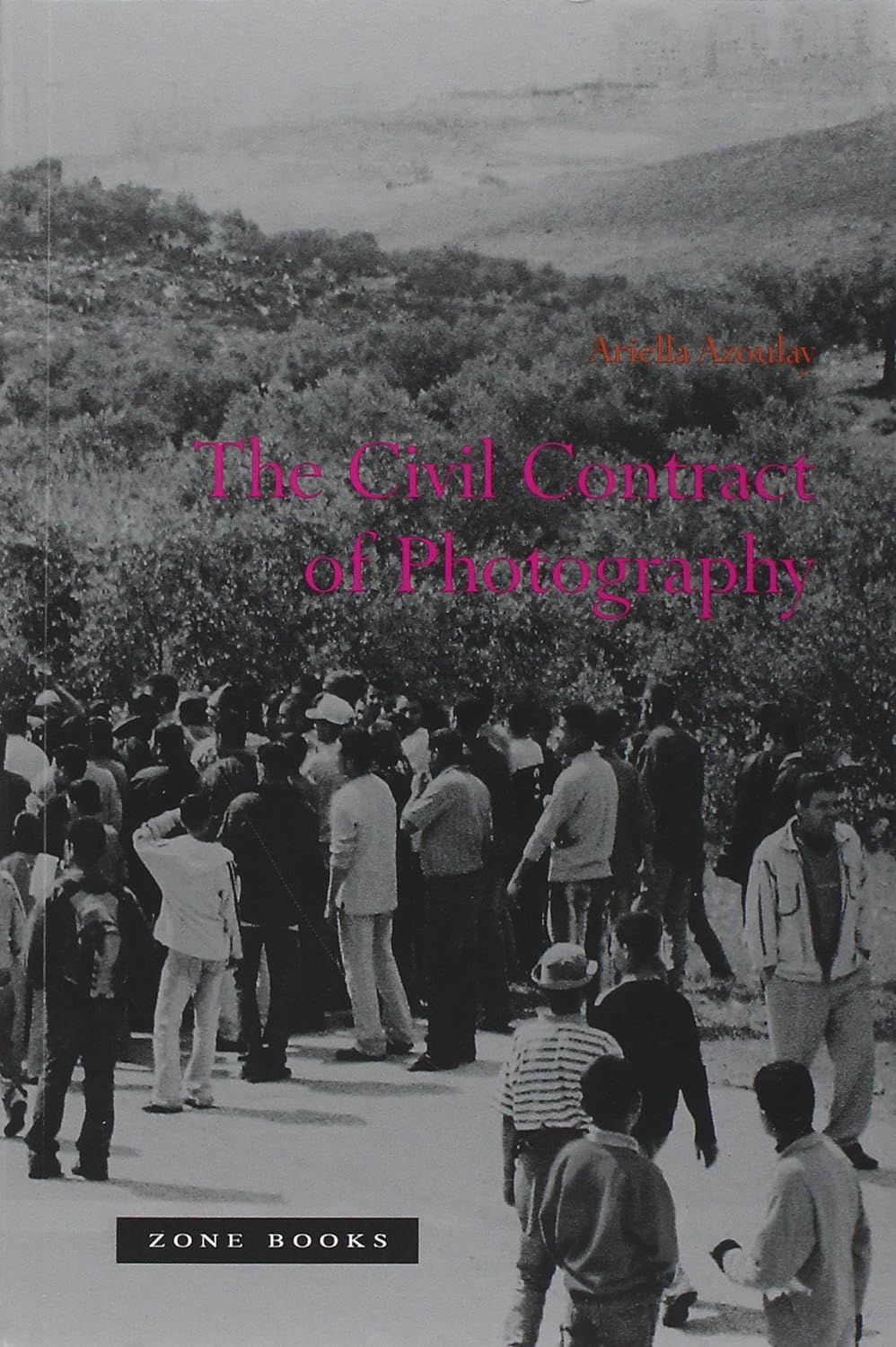Introduction: “The Civil Contract of Photography” by Ariella Azoulay, published in 2008, is a seminal work that redefines the understanding of photography in contemporary visual culture. Azoulay, a scholar in visual culture and political theory, presents a comprehensive analysis that challenges traditional notions of photography and proposes a new framework for interpreting photographs, especially those depicting suffering and political conflict.
1. The Concept of the Civil Contract
Redefining Photography:
- Azoulay introduces the concept of the “civil contract” in relation to photography, arguing that photographs are not mere images but part of a civic space where spectators, photographers, and subjects are interconnected.
- This civil contract is an implicit agreement among these parties to acknowledge the presence and rights of each other, particularly the photographed subjects.
Political and Ethical Framework:
- The book proposes that photography should be understood within a political and ethical framework rather than solely as an artistic or technical practice.
- This framework emphasizes the responsibilities of viewers and the rights of subjects, advocating for a more engaged and ethical approach to viewing photographs.
2. Photography and Citizenship
The Citizenry of Photography:
- Azoulay discusses the idea of a “citizenry of photography,” where the act of viewing a photograph is a form of political engagement and civic participation.
- She argues that photographs, especially those of suffering or injustice, demand a response from viewers, making them active participants in the civic space created by the image.
Visual Citizenship:
- The book introduces the concept of “visual citizenship,” where viewing and interpreting photographs is an act of claiming one’s rights and recognizing the rights of others.
- This notion challenges passive consumption of images, urging viewers to engage critically and empathetically with photographs.
3. The Ethics of Viewing
Moral Responsibility:
- Azoulay emphasizes the moral responsibility of viewers when encountering images of suffering and conflict. She argues that viewers have a duty to respond ethically to the subjects depicted in photographs.
- This ethical engagement involves recognizing the humanity of the subjects and the broader social and political contexts of their suffering.
The Spectator’s Role:
- The book critiques the detachment often experienced by viewers of photographs, particularly those in the media. Azoulay advocates for a more active and empathetic role for spectators.
- By acknowledging the subjects’ plight and considering the implications of their suffering, viewers become part of a larger community of care and responsibility.
4. Photography as Evidence
Documentary Function:
- Azoulay explores the documentary function of photography, arguing that photographs serve as evidence of events, conditions, and experiences.
- She discusses how photographs can bear witness to historical and contemporary injustices, playing a crucial role in documenting and raising awareness about social and political issues.
Challenges of Authenticity:
- The book addresses the challenges of authenticity and truth in photography. Azoulay acknowledges that photographs can be manipulated or misinterpreted but argues that their potential to reveal truths about the human condition remains significant.
- She calls for a critical approach to interpreting photographs, considering their context and the intentions behind their creation and dissemination.
5. The Intersection of Photography and Human Rights
Human Rights Discourse:
- Azoulay situates her analysis within the broader discourse of human rights, asserting that photographs can serve as powerful tools for advocating and defending human rights.
- She examines how images of suffering and injustice can mobilize public opinion and spur action towards social and political change.
Photographic Interventions:
- The book discusses specific instances where photography has been used to document human rights abuses and advocate for justice. Azoulay highlights the role of photographers in exposing atrocities and the impact of their work on public consciousness.
- She argues that photography can contribute to a culture of human rights by making visible the experiences and struggles of marginalized and oppressed individuals.
6. The Power Dynamics in Photography
Power Relations:
- Azoulay explores the power dynamics inherent in the act of photographing and being photographed. She examines how power relations are embedded in the production, circulation, and reception of photographs.
- The book discusses how photographers, subjects, and viewers each hold different degrees of power and influence in the photographic process.
Agency and Representation:
- A key theme is the agency of photographed subjects and their representation. Azoulay argues that subjects should not be seen merely as passive objects but as active participants with their own voices and perspectives.
- She calls for a more respectful and inclusive approach to photographing and viewing, where the dignity and agency of subjects are upheld.
7. Case Studies and Examples
Historical and Contemporary Examples:
- Azoulay uses a range of historical and contemporary examples to illustrate her arguments. These case studies include iconic photographs from war zones, images of political protests, and documentation of social injustices.
- By analyzing specific photographs and the contexts in which they were created and viewed, Azoulay provides concrete evidence of the concepts and themes she discusses.
Impactful Photographs:
- The book highlights photographs that have had a significant impact on public awareness and policy, demonstrating the potential of photography to influence social and political outcomes.
- Azoulay discusses the ways in which these images have been used to advocate for change and the ethical considerations involved in their creation and dissemination.
Conclusion
“The Civil Contract of Photography” by Ariella Azoulay is a profound and thought-provoking work that redefines the role of photography in contemporary visual culture. By introducing the concept of the civil contract, Azoulay challenges traditional notions of photography and emphasizes the ethical and political responsibilities of viewers. The book’s exploration of themes such as citizenship, human rights, and power dynamics offers a comprehensive framework for understanding the complex interactions between photographers, subjects, and viewers. Through its innovative approach, “The Civil Contract of Photography” calls for a more engaged and empathetic viewing of photographs, highlighting the potential of photography to foster social and political change.
Additional Resources:
For more in-depth reviews and insights, you may refer to the following links:

